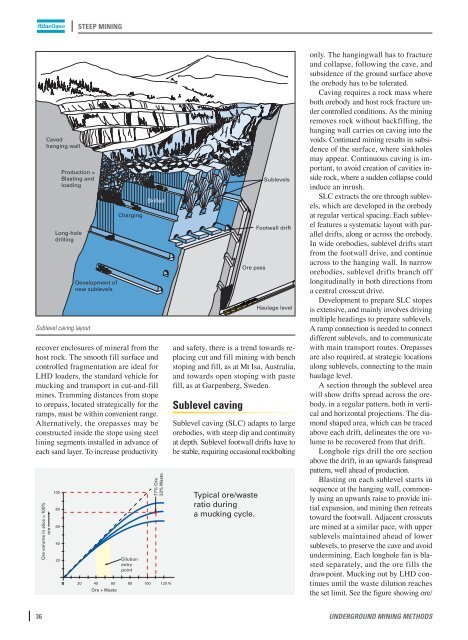Mining_Methods_UnderGround_Mining - Mining and Blasting
Mining_Methods_UnderGround_Mining - Mining and Blasting
Mining_Methods_UnderGround_Mining - Mining and Blasting
Create successful ePaper yourself
Turn your PDF publications into a flip-book with our unique Google optimized e-Paper software.
Sublevel caving layout.<br />
STeeP <strong>Mining</strong><br />
recover enclosures of mineral from the<br />
host rock. The smooth fill surface <strong>and</strong><br />
controlled fragmentation are ideal for<br />
LHD loaders, the st<strong>and</strong>ard vehicle for<br />
mucking <strong>and</strong> transport in cut-<strong>and</strong>-fill<br />
mines. Tramming distances from stope<br />
to orepass, located strategically for the<br />
ramps, must be within convenient range.<br />
Alternatively, the orepasses may be<br />
constructed inside the stope using steel<br />
lining segments installed in advance of<br />
each s<strong>and</strong> layer. To increase productivity<br />
Ore volume in slice = 100%<br />
ore<br />
Caved<br />
hanging wall<br />
Production =<br />
<strong>Blasting</strong> <strong>and</strong><br />
loading<br />
Long-hole<br />
drilling<br />
100<br />
80<br />
60<br />
40<br />
20<br />
Development of<br />
new sublevels<br />
Charging<br />
Dilution<br />
entry<br />
point<br />
Drilled<br />
77% Ore<br />
33% Waste<br />
0 20 40 60 80 100 120 %<br />
Ore + Waste<br />
<strong>and</strong> safety, there is a trend towards replacing<br />
cut <strong>and</strong> fill mining with bench<br />
stoping <strong>and</strong> fill, as at Mt Isa, Australia,<br />
<strong>and</strong> towards open stoping with paste<br />
fill, as at Garpenberg, Sweden.<br />
Sublevel caving<br />
Ore pass<br />
Sublevels<br />
Footwall drift<br />
Haulage level<br />
Sublevel caving (SLC) adapts to large<br />
orebodies, with steep dip <strong>and</strong> continuity<br />
at depth. Sublevel footwall drifts have to<br />
be stable, requiring occasional rockbolting<br />
Typical ore/waste<br />
ratio during<br />
a mucking cycle.<br />
only. The hangingwall has to fracture<br />
<strong>and</strong> collapse, following the cave, <strong>and</strong><br />
subsidence of the ground surface above<br />
the orebody has to be tolerated.<br />
Caving requires a rock mass where<br />
both orebody <strong>and</strong> host rock fracture un-<br />
der controlled conditions. As the mining<br />
removes rock without backfilling, the<br />
hanging wall carries on caving into the<br />
voids. Continued mining results in subsi-<br />
dence of the surface, where sinkholes<br />
may appear. Continuous caving is important,<br />
to avoid creation of cavities in-<br />
side rock, where a sudden collapse could<br />
induce an inrush.<br />
SLC extracts the ore through sublevels,<br />
which are developed in the orebody<br />
at regular vertical spacing. Each sublevel<br />
features a systematic layout with parallel<br />
drifts, along or across the orebody.<br />
In wide orebodies, sublevel drifts start<br />
from the footwall drive, <strong>and</strong> continue<br />
across to the hanging wall. In narrow<br />
orebodies, sublevel drifts branch off<br />
longitudinally in both directions from<br />
a central crosscut drive.<br />
Development to prepare SLC stopes<br />
is extensive, <strong>and</strong> mainly involves driving<br />
multiple headings to prepare sublevels.<br />
A ramp connection is needed to connect<br />
different sublevels, <strong>and</strong> to communicate<br />
with main transport routes. Orepasses<br />
are also required, at strategic locations<br />
along sublevels, connecting to the main<br />
haulage level.<br />
A section through the sublevel area<br />
will show drifts spread across the ore-<br />
body, in a regular pattern, both in vertical<br />
<strong>and</strong> horizontal projections. The dia-<br />
mond shaped area, which can be traced<br />
above each drift, delineates the ore volume<br />
to be recovered from that drift.<br />
Longhole rigs drill the ore section<br />
above the drift, in an upwards fanspread<br />
pattern, well ahead of production.<br />
<strong>Blasting</strong> on each sublevel starts in<br />
sequence at the hanging wall, commonly<br />
using an upwards raise to provide initial<br />
expansion, <strong>and</strong> mining then retreats<br />
toward the footwall. Adjacent crosscuts<br />
are mined at a similar pace, with upper<br />
sublevels maintained ahead of lower<br />
sublevels, to preserve the cave <strong>and</strong> avoid<br />
undermining. Each longhole fan is bla-<br />
sted separately, <strong>and</strong> the ore fills the<br />
drawpoint. Mucking out by LHD continues<br />
until the waste dilution reaches<br />
the set limit. See the figure showing ore/<br />
36 underground mining methods
















